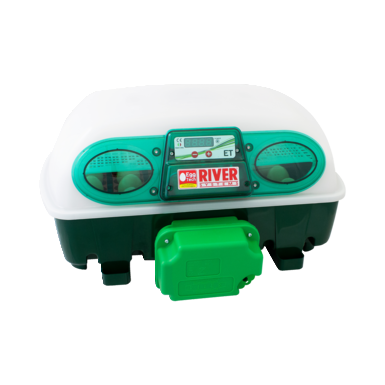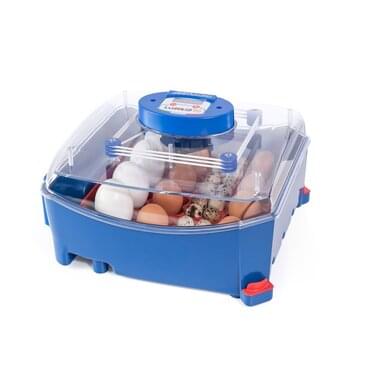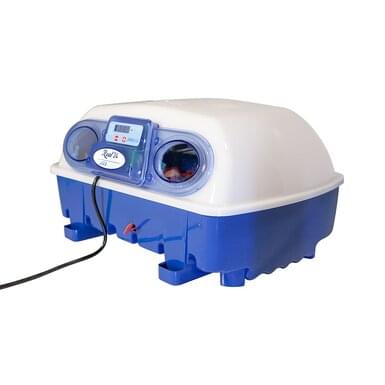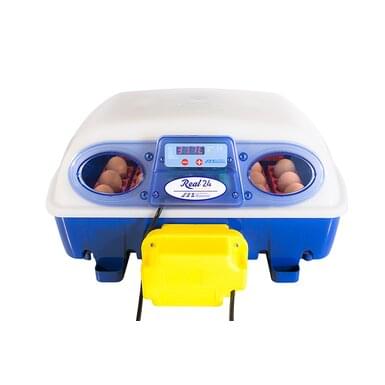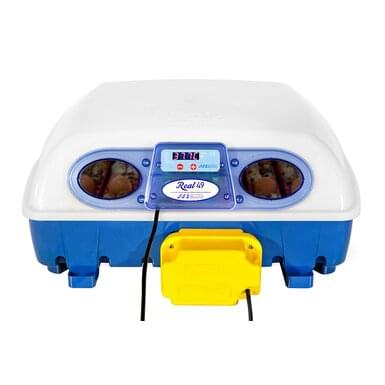Incubators
Incubator ET24 | fully automatic for up to 24 eggs
- Flexible use thanks to adaptable design
- Sophisticated monitoring thanks to viewing windows and digital display
- High hatching rate thanks to fully automatic egg turning every 2 hours
- Precise temperature and humidity regulation
Borotto incubator Lumia | automatic | digital (16 eggs)
- Digital temperature display
- ABS material with strong thermal insulation
- Plastic with antibacterial additive Biomaster
- Optimized angle of inclination of the eggs
Borotto Incubator | semi-automatic | digital (24 eggs)
- Digital temperature display
- Control window for monitoring the incubation phases
- Water can be filled without opening the apparatus
- Thermal insulation through warm air
Borotto incubator | automatic | digital (24 eggs)
- Digital temperature display
- Water can be filled without opening the apparatus
- Thermal insulation through warm air
- Static humidification system
Borotto incubator | automatic | digital (49 eggs )
- Precise temperature control
- Thermal insulation
- Static humidification system
- Excellent view of the interior
Incubators for poultry
When breeding chickens, an incubator is indispensable. Incubation should not be left to chance, because certain temperatures and humidity are needed so that the eggs can develop as desired. An incubator reliably covers these points and you have the choice between different incubators - automatic or manual.
Advantages of the incubator
-
You can choose any time for the start of incubation
- No interruption of the hens' laying phase
-
Larger quantities of eggs can be hatched at the same time
-
Chicks without a hen are more trusting
-
The brood can be checked at any time by means of the viewing window
The incubator serves best as an incubator and thus creates optimal conditions for hatching, so you do not have to rely on the hens. Especially in hobby breeding, disappointments of unhatched eggs or underdeveloped chicks can be avoided.
What kind of incubators are there?
The incubators differ fundamentally only in the motor installed - in whether the egg is turned fully automatically or you have to do it yourself. Whether you buy an automatic or semi-automatic incubator is up to you. There are also different sizes of incubator. The smallest capacity is the Borotto Incubator Lumia with 8 eggs and an automatic egg turner. Again, the largest capacity with 49 eggs is the Burotto incubatoralso with an automatic turner. Automatic or semi-automatic, both devices have an electronic temperature display. The temperature remains constant through the viewing windows and you can check the incubation at any time.
What should be considered?
Location
Ensure a dry and well-ventilated environment for the incubator. Also consider that the ambient temperature must be at least 10° C and max. 20-25° C.
Putting the incubator into operation
Before using the incubator for chick rearing, let it run empty once so that it can warm up properly. Also check that the temperature and humidity remain constant. If all this is the case, you can use the incubator to hatch the eggs.
Temperature
The optimal temperature for chicken eggs in the incubator would be 37.5° C. Three days before the chicks hatch, the eggs are moved from the turning rack to the hatching rack and the temperature should be lowered by 0.3° C, as the intrinsic heat in the egg increases during the last three days.
Humidity
Humidity is particularly important, as if it is too low the chicks will not develop properly and may get stuck in the egg during hatching.
During hatching, you should therefore make sure that the humidity is between 50% and 65%. In the last three days you can increase the humidity to 80 %.
Cleaning the incubator
To prevent germs from multiplying in the incubator, you should clean it thoroughly after incubation. First wash out the machine with washing-up liquid and then disinfect it. The turning tray and hatching tray are cleaned with a sponge or brush after each brood.
After brooding
After hatching, the chicks need further warmth at the age of 8 to 12 weeks, gradually adjusting to the ambient temperature. Here you can use Heat plates or infrared lamps can be used. However, the heat plates are recommended, they are height-adjustable and grow with the chicks. The heat is also optimally diffused and you have lower power consumption than with a heat lamp.
Why horizont brooders?
In our online shop you will find a large selection of different products, depending on your desired use you will find the optimal device for your poultry farming. Our devices are particularly robust and ensure reliable and safe chick rearing. You will also find suitable accessories such as heating plates, humidifiers, shearing lamps and thermometers.


